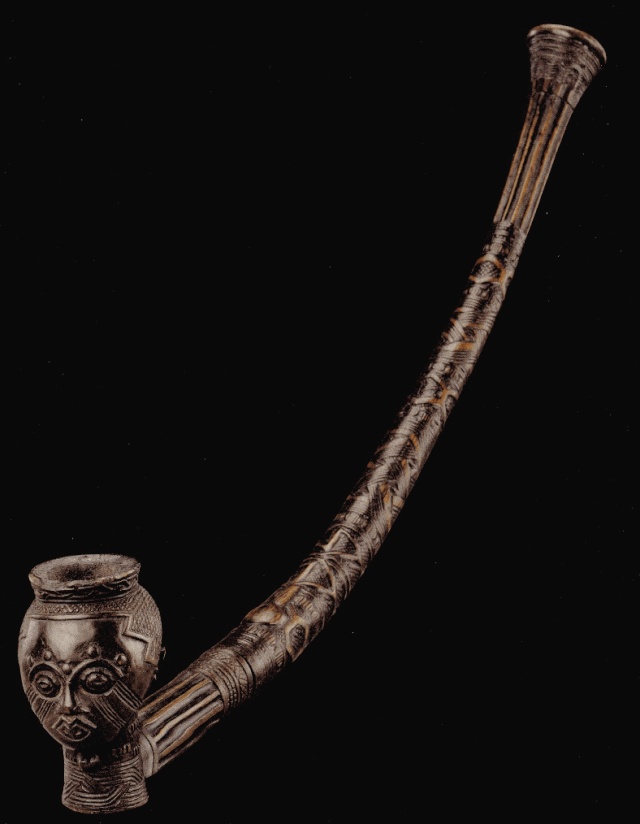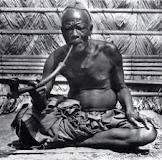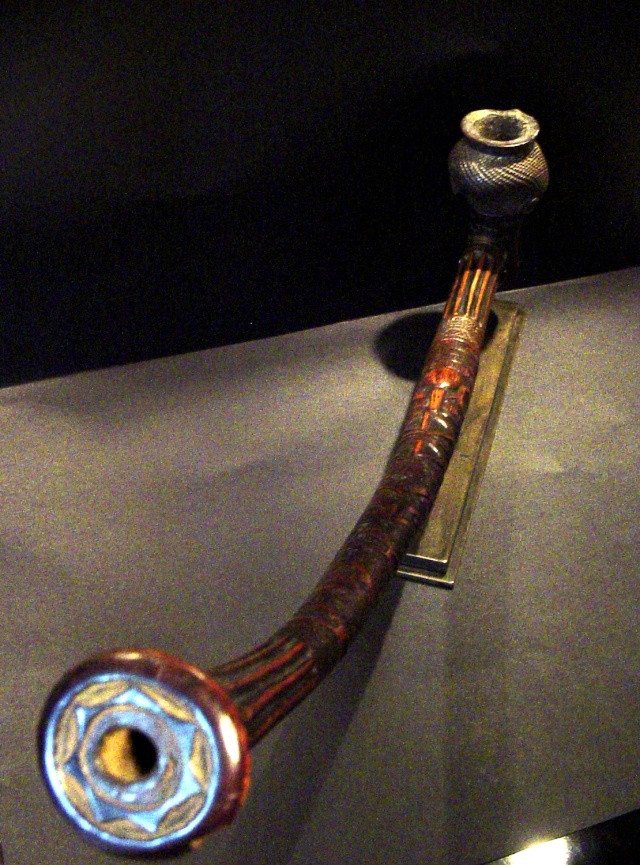Kuba people, Pipe by the Kingdom Dignitaries, Kasai Area
Pagina 1 di 1
 Kuba people, Pipe by the Kingdom Dignitaries, Kasai Area
Kuba people, Pipe by the Kingdom Dignitaries, Kasai Area

Kuba people, Pipe by the Kingdom Dignitaries, Kasai Area, Congo
L. 19,7 in /50 cm
Wood with deep brown patina
19th century
Private collection Italy,
Photo Courtesy Frederick Dehaen (Studio Asselbergh- Bruxelles), Tomaso Vigorelli and Onda Predali
Arti delle Mani Nere All Rights Reserved
La pipe a été ramenée par un médicin belge qui a travaillé au Congo (Kasai) pour la Société Internationale Forestière et Minière du Congo (Forminière) au début XX sec.
Provenence
Old Private collection, Belgium
Pierre Loos Gallery, Bruxelles
Philippe et Lisa Laeremans Gallery, Bruxelles
Ex Dalton Somaré Gallery, Milano
Exhibition
"Confrontation", Bruxelles, Philippe et Lisa Laeremans Gallery, 2008
“ Winter Bruneaf “ Bruxelles, 2008.
“ Scultura. Arte dell’Africa “, Dalton Somaré Gallery, Milano, 2009.
“L’Africa delle Meraviglie. Arti Africane nelle collezioni italiane”. Museo Palazzo Ducale, Genova, December 2010 – 5th June 2011.
Published
-Glave E.J. “ Six Years of Adventure in Congo-Land “ R.H.Russell ed. New York, 1892, pag.97, image b/w of an equal pipe.

-David A. Binkly, Patricia Darish “ Vision d’Afrique. Kuba”,Milano, 5 Continents ed. 2009, pag. 33 color, pag.124 b/n.
-Catalogo Esposizione “ Scultura, L’arte dell’Africa “, Milano, Dalton Somaré, 2009, pag. 51, 52 color.
The tobacco's plant was introduced by the Portugueses in Congo in early 1600 and the Kuba people it soon became an heavy users. At the beginning of 1900, Frobenius writes of the great difficulties in attempting to acquire, on behalf of the Ethnological Museum of Hamburg, the decorated great pipe with men Pyaang, because they were the jealous guardians and owners of it and they were not willing to yield, this type of objects, just a final alst possibility.
This type of pipe, curve and massive in size, like the other two in the Catalogue of the Tervuren Museum, were pipes that were worn at the waist and flaunted by dignitaries of the Kingdom and therefore were items for the representation of power and rank as well as being used for the primary purpose of the smoke, as denote the evident signs of use.


"Le petit fourneau délicat de cette pipe répresente une masque Kuba, avec des " lignes de larmes "caractéristiques qui s'étendent à partir des yeux à travers le visage. Les petites bosses sur la front au dessus de l'arc du sourcil ont été sculptées dans le bois pour simuler les punaises en laiton qui décorent les masques Kuba.
…..Ces caractéristiques font reference à quelques masque Kuba, notamment bongo et bwoom, que possédaient les sociétés d’initiation des jeunes hommes de certaines communautés….
Cette attention méticuleuse au détail est la marque de la sculpture sur bois kuba à son plus haut niveau."( Binkley and Darish, 2009)
The bowl of the pipe refers to the typical characteristics of Kuba masks. The incisions along the stem, are representative of the distinctive features of patterned fabrics ( buiin) of this ethnic group (Kuba/Shoowa). These two jointed features, together with the balance of shapes and sizes, make this object a work of special artistic value and historical / documentary of the Kuba Art.
Bibliography
-E.J. Glave “ Six Years of Adventure in Congo-Land “ R.H.Russell ed. New York, 1892
-Vansina, Jan, “Kuba Art and its Cultural Context”, in African Forum, p. 3-4, 13-27, 1968
Rogers, Donna C, “Royal Art of the Kuba”, Austin University of Texas Art Museum, 1979
-Cornet, Joseph, “Art royal Kuba”, Milano, Sipiel, 1982
-Darish, Patricia, “This is our Wealth: towards an Understanding of a Shoowa Textile Aesthetic”, in Elvehjem Museum of Art Bulletin, University of Wisconsin, Madison, 1996
-Binkley, David A. and Darish Patricia, “Visions d’Afrique. Kuba”, 5 Continents Editions, Milano, 2009
Yale University Art Gallery, n.0102236-01

Kuba, Pipa riservata ai Dignitari di Corte, Regione del Kasai, Congo
Lunghezza 50 cm.
Legno, profonda patina d’uso
XIX sec.
Collezione privata, Italia
Foto Courtesy Frederick Dehaen (Studio Asselbergh- Bruxelles), Tomaso Vigorelli e Onda Predali
Arti delle Mani Nere All Rights Reserved
La pipa è stata raccolta agli inizi del ‘900 da un medico belga che lavorava in Congo, nella regione del Kasai, per conto della Société Internationale Forestière et Minière du Congo (Forminière )
Provenienza
Antica Collezione privata, Belgio
Galleria Pierre Loos, Bruxelles
Galleria Philippe et Lisa Laeremans, Bruxelles
Galleria Dalton Somaré, Milano
Esposizioni
" Confrontation ", Bruxelles, Philippe et Lisa Laeremans Gallery, 2008
“ Winter Bruneaf “ Bruxelles, Belgio, 2008.
“ Scultura. Arte dell’Africa “, Gall. Dalton Somaré, Milano, 2009.
“L’Africa delle Meraviglie. Arti Africane nelle collezioni italiane”
Museo Palazzo Ducale, Genova, 30 dicembre 2010-5 giugno 2011
Pubblicazioni
E.J.Glave “ Six Years of Adventure in Congo-Land “ R.H.Russell ed. New York, 1892, pag.97, illustrazione b/n di una pipa similare.
David A. Binkly, Patricia Darish “ Vision d’Afrique. Kuba “, Milano, 5 Continents ed. 2009, pag. 33 color, pag.124 b/n.
Catalogo Esposizione “ Scultura. L’arte dell’Africa “, Milano, Dalton Somaré, 2009, pag.51, 52 color.
Il tabacco fu introdotto in Congo dai Portoghesi agli inizi del 1600 e la popolazione Kuba ne divenne presto un forte consumatore. Già agli inizi del 1900, Frobenius scrive delle grandi difficoltà nel tentativo di acquisire, per conto del Museo Etnologico di Amburgo, le grandi pipe decorate presso gli uomini Pyaang, in quanto i possessori ne erano gelosi custodi e non cedevano, se non per ultimi, questo tipo di oggetti.
Questa tipologia di pipa, curva ed imponente per dimensione, come le altre due del Catalogo del Tervuren Museum, erano pipe che venivano portate ed ostentate alla cintola dai dignitari della corte e pertanto erano oggetti destinati alla rappresentazione del potere e del rango oltre che essere utilizzati per il precipuo scopo del fumare, come denotano gli evidenti segni d'uso.

"Il piccolo raffinato fornello di questa pipa rappresenta una maschera Kuba, con le caratteristiche “linee delle lacrime” che scendono dagli occhi su tutto il viso.
Piccole protuberanze sulla fronte sopra le sopracciglia, sono scolpite nel legno a imitazione delle bullette in ottone che decorano le maschere Kuba.
… Queste caratteristiche fanno riferimento a qualche maschera Kuba, in particolare bongo e bwoom, possedute dalle società di iniziazione dei giovani in alcune comunità …
L’ attenzione meticolosa per i particolari è il segno distintivo della scultura lignea dei Kuba quando si esprime al massimo livello.” ( Binkley and Darish, 2009)

Il fornello della pipa rimanda alle caratteristiche tipiche delle maschere Kuba. Le incisioni lungo tutto il cannello, sono invece rappresentative dei motivi geometrici peculiari dei tessuti della popolazione Kuba/ Shoowa (buiin). Queste due caratteristiche accumunate, unitamente all'equilibrio delle forme e dei volumi, fanno di questo oggetto un'opera di particolare significato artistico e storico/documentativo dell'Arte Kuba
Bibliografia
-Glave,E.J, “Six Years of Adventure in Congo-Land “ R.H.Russell ed. New York, 1892
-Vansina, Jan, “Kuba Art and its Cultural Context”, in African Forum, p. 3-4, 13-27, 1968
-Rogers, Donna C, “Royal Art of the Kuba”, Austin University of Texas Art Museum, 1979
-Cornet, Joseph, “Art royal Kuba”, Milano, Sipiel, 1982
-Darish, Patricia, “This is our Wealth: towards an Understanding of a Shoowa Textile Aesthetic”, in Elvehjem Museum of Art Bulletin, University of Wisconsin, Madison, 1996
-Binkley, David A. and Darish, Patricia, “Visions d’Afrique. Kuba”, 5 Continents Editions, Milano, 2009
Yale University Art Gallery, n. 0102236-01

Pagina 1 di 1
Permessi in questa sezione del forum:
Non puoi rispondere agli argomenti in questo forum.
 Indice
Indice